Annual Review
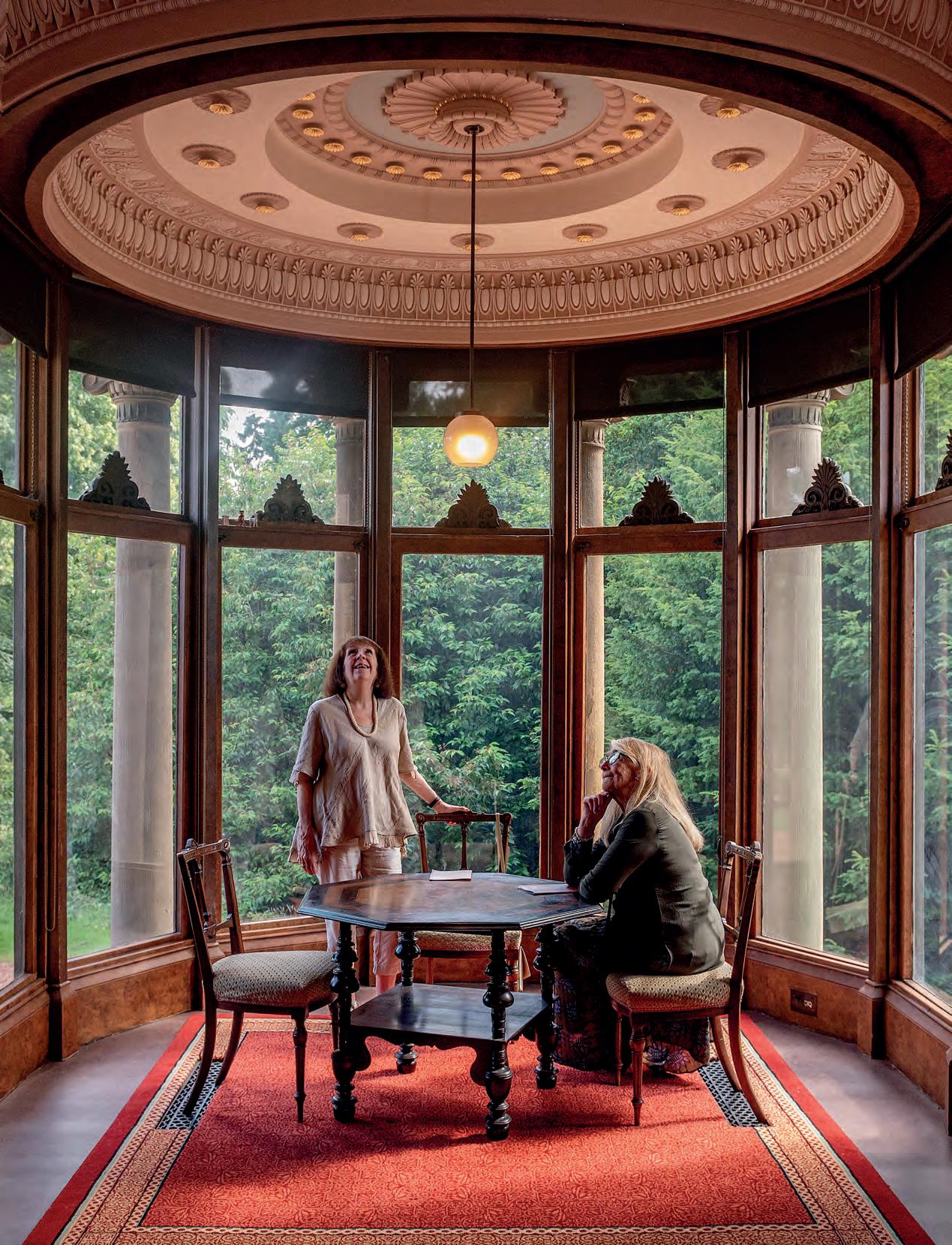




The National Trust for Scotland is the charity that cares for, shares and speaks up for Scotland’s heritage.
Scotland has exceptional nature, beauty and heritage – we believe everyone should have access to this. We’re Scotland’s largest membership organisation and we’re independent from government.
Since 1931, we’ve pioneered public access to some of the most magnificent buildings, collections and landscapes in Scotland. We care for ancient houses, battlefields, castles, mills, gardens, coastlines, islands and mountain ranges, as well as the plants and animals that live in these varied habitats.
Together, these places and objects tell the stories of Scotland and the Scots: how they travelled and interacted with the wider world, returning with new ideas. Without our involvement, many places would have been lost either to time, development or the elements.
We work to fulfil our vision of nature, beauty and heritage for everyone, and continue to protect Scotland’s special places for future generations.
Archaeology is a vital part of our research and conservation work, providing a sound understanding of what we’re protecting. To learn more about our places, our ancestors and the way people once lived, we study the artefacts they left behind, from pieces of flint used for tools to broken pottery from the 19th century, as well as numerous built structures. We love to share new discoveries with our members and get people excited about Scotland’s past culture.
In addition to actively caring for the places under our protection, we also speak up for the better management of our national heritage and support improved public access and enjoyment of our cultural and natural treasures.
Our advocacy work incorporates campaigning as well as research and specialist studies of our landscape and built heritage.
Our portfolio of buildings celebrates the richly varied architectural history of Scotland. We protect 11 castles, a royal palace and numerous historic houses and vernacular buildings. We are also responsible for maintaining the sites of some of the most important episodes in Scotland’s history, including Culloden Battlefield and Bannockburn, as well as iconic structures such as Glenfinnan Monument.
Around 300,000 objects can be found across 50+ properties, including one of the greatest collections of art in Scotland. Studying the contents of our castles and houses helps us to learn more about and feel closer to the people who built, furnished and worked in them.
Every object – from clothes to candlesticks and teapots to oil paintings – tells a story. By keeping so many historical artefacts in their original setting, we’re able to paint a vivid picture of Scotland’s past.
We tend and manage 39 important gardens and designed landscapes. In these, we cultivate over 100,000 individual plants, both native and exotic.
We’re the largest garden owner in Scotland. Our staff are experts in environmental issues such as biodiversity, climate change, energy conservation, water management and the way we handle non-native species.
We care for more than 76,000 hectares of countryside, home to world-famous landscapes and a vast amount of Scotland’s wildlife. We look after 8 National Nature Reserves (NNRs), 46 Munros (some of Scotland’s highest mountains) and countless islands and islets. Within the multitude of natural habitats in our care comes an abundance of rare and remarkable wildlife. Guided by careful monitoring and pioneering conservation efforts, we work to protect our places that support all kinds of animal and plant communities, from red squirrels and seabirds to montane scrub and ancient trees.
His Majesty King Charles III
President
Jackie Bird
Caroline Borwick
Professor Hugh Cheape
The Duchess of Fife
Professor Michael Scott-Morton
Sir Mark Jones, Chair
David Mitchell, Deputy Chair
Janet Brennan
Dr James Fenton
David MacLellan
Shona Malcolm
Jill Miller
Stephen Mitchell
Cameron Murray
Professor Murray Pittock
Michael Spence
Ian Turnbull
Philip Long OBE, Chief Executive
Katerina Brown, Chief Operating Officer
Stuart Brooks, Director of Conservation & Policy
Jane Ferguson, Director of Audiences & Support
David Frew, Head of Mar Lodge Estate
Iain Hawkins, Regional Director (North East)
Stuart Maxwell, Regional Director (Edinburgh & East)
Ian McLelland, Regional Director (South & West)
Pam Milne, People Director
Michael Terwey, Director of Public Engagement & Research
Clea Warner, Regional Director (Highlands & Islands)
I am glad to report that 2022 was a better year for the National Trust for Scotland. Our properties reopened, visitor numbers rose –if not quite to pre-pandemic levels – and our income and expenditure both increased as we began to tackle the backlog of conservation that built up during the periods of lockdown.

Our ongoing work to protect and provide access to the mountains, islands, castles and cottages in our care, as well as some major initiatives and achievements of the year, is outlined in this report. I hope that you will find it interesting and impressive.
On my own behalf and that of the Board, I would like to thank our volunteers and members. We would not be able to carry out our conservation work without your support and commitment. I’d also like to extend my warm thanks to all our donors, who have done so much to further our work this year. Their enthusiasm and generosity are enormously valued.
And I would like to offer my especial thanks to the 180 people who left bequests to support the Trust. Remembering the National Trust for Scotland in your Will is one of the best ways of ensuring that the places we all love will be looked after in the future.
Included in the support received this year was the very generous bequest of £1.8m from Mrs Colquhoun, a Life member of the Trust who lived in Canada. We are very grateful for all bequests, including £10,000 to enable garden improvements at Inverewe from Mrs Jackson; £11,000 to benefit the Hill House and Crarae Garden from Mrs Clark; and £5,000 to our Footpath Fund from Mrs Bainbridge. Such kindness is deeply appreciated, and their legacy will live on in the pleasure that millions of people experience when visiting our places.
Thanks to the support of our members and donors, the Trust is confidently looking forward, explains Sir Mark Jones, Chair of the National Trust for Scotland.
Chief Executive Philip Long looks at some highlights from the past year and explains how the Trust’s vision and our supporters enable our vital conservation work to happen.
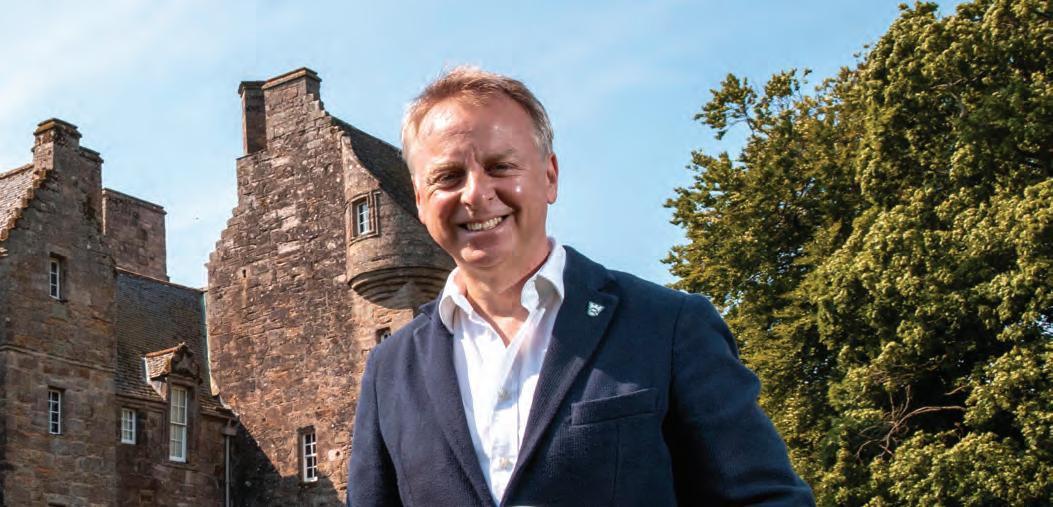
Our visitor numbers, while not yet at pre-pandemic levels, reached 3.6 million for the year, and our membership numbers have been growing too. We are a charity like no other, responsible for the protection of natural and cultural heritage across the country. Everyone can benefit from our work and our cause, and so it is wonderful to welcome so many people at our places throughout Scotland.
One year into our ambitious ten-year strategy Nature, Beauty & Heritage for Everyone, the Trust is more confident. Our strategy is shaped around the three founding pillars of conservation, engagement and sustainability, which combine to deliver our charitable purpose. Throughout this review we are delighted to share our progress in these areas.
As we complete some projects and start work on others, we continue to champion the care of Scotland’s heritage for the benefit of all, now and for future generations. Major projects in the past year include the reopening of House of the Binns, following its restoration over several years; the completion of our investment at Corrieshalloch Gorge NNR, providing essential visitor facilities and improved access to enable people to further enjoy this extraordinary National Nature Reserve; and our first major acquisition since 2015 of the Treshnish Isles, an archipelago rich in natural and cultural heritage.
These successes help us to grow in confidence and bolster our resilience in tackling a range of challenges, in particular the climate and nature crises. Over the last year, properties were badly affected across the Trust’s estate by extreme weather events such as the successive storms Arwen, Malik and Corrie, which brought down
Looking back on the past year at the Trust, I’m delighted to say it has been distinguished by openings, acquisitions, and transformations of the places, collections and landscapes we are proud to care for.
trees, damaged buildings and had a devastating effect on natural habitats. Our teams responded bravely to these emergencies, all the while working on a variety of pioneering, nature-based projects to address the difficulties our world faces.
We have also completed another project to restore natural habitats on Mar Lodge Estate NNR in the heart of the Cairngorms, one of Scotland’s most sublime landscapes. The watercourse through the long Geldie Valley is rising in temperature, threatening the wildlife that lives within it. With generous support, we have planted 102,000 native trees along the Geldie Burn in fenced enclosures over an area equivalent to the size of nearly 170 football pitches. In time, these trees will provide essential shade to protect species that depend on this habitat.
We continue to monitor the health of seabird populations, many of which are sadly in decline due to the devastation of avian flu and other suspected factors such as food availability and, potentially, climate change. As an independent charity, we rely on the generosity of our members and supporters who enable our conservation work. This has especially been the case with our seabird work, supported by our members through a specific appeal, as well as by the singular commitment of two of our most generous Patrons’ Club members.
Contained within our many properties are wonderful collections of art, design, archives and artefacts. Protecting such heritage is, of course, just as vital as caring for our buildings and landscapes. In the past year we were proud to be part of a consortium from across the UK, led by the Friends of the National Libraries, that worked together to secure for the nation the Blavatnik Honresfield Library, priceless in its significance to British literary heritage. From this library, precious manuscripts by Robert Burns have now joined our collections.
Working to make our collections accessible to all has received special emphasis too, as we embarked on a project to digitise for the first time our complete Burns holding; this work was also made possible by the generosity of one of our Patrons’ Club members. The importance of partnership was further highlighted through our involvement with fellow bodies across Scotland in contributing to the new national historic
environment strategy – Our Past, Our Future – setting out a coordinated plan for the care and significance of Scotland’s treasured heritage in the years to come. As well as widening access to our collections, we are also helping visitors understand more about the people at our places in the past. The ongoing Facing Our Past project researches the legacies of slavery in Scotland as part of the wider, extensive research we undertake across many historical subjects.
Looking ahead, by spring 2024 the scaffolding will come down at Craigievar Castle to reveal the restored limewash, distinctive pinkcoloured harling and the completed repairs to the complex roof and elaborate carvings. The conservation work currently underway at Brodick Castle and Drum Castle will be nearing completion too, contributing to our strategy’s long-term objective to stabilise and improve the condition of our estate. Meanwhile, the Hill House continues to dry out under its protective and breathable Box, enabling conservation and restoration work to take place that will ensure the long-term future of this architectural masterpiece, with its precious interiors by Charles Rennie Mackintosh and Margaret Macdonald Mackintosh.
People – and especially our volunteers – are at the heart of our charity, and we have been delighted to appoint Jackie Bird, the renowned journalist, broadcaster and committed friend of the Trust, as our President. We are very pleased to welcome, too, the marine expert and intrepid explorer Cal Major as our volunteer ambassador, helping us to give further voice to protecting and standing up for nature.
Since 1931, the National Trust for Scotland has been an organisation which has spoken up for the importance of conservation and nature, and the significance of heritage in everybody’s lives. Given all we have been through in the last few years and the uncertainty ahead, the protection of our environment – for its own sake and for the wellbeing of our communities, our society and our economy –has never been more important.
The Trust’s work in this can only be achieved thanks to our wonderful staff, volunteers, Trustees, committee members and generous supporters. As you will see in the pages that follow, a lot has been achieved in the past year and we look forward to sharing with you even more in the future as we continue our work to care for, share and promote Scotland’s magnificent heritage.
As an independent charity, we rely on the generosity of our members and supporters who enable our conservation work.
Behind the nature, beauty and heritage enjoyed by our members and visitors, a whole raft of people work hard to sustain the places in our care.

These include professional staff engaged in the Trust’s finances, commercial activities, rental properties and other support services, such as legal, governance, IT and our newly formed Project Management Office.
After managing our way financially through the global pandemic, the last year has been one of recovery and rebuilding. We’ve reopened our properties and made significant operational and financial improvements to ensure that we not only build back but do so better and stronger than before. We’re doing this by recruiting people with the skills we need to tackle the current challenging economic environment, so we can support and deliver our charity’s ambitions. We understand the diverse and
far-reaching portfolio of the Trust requires an equally varied and often novel approach to management and problem solving. That’s why we’re initiating new activities and making investments to make the Trust more resilient and sustainable.
This includes a new Finance, Planning & Analysis team, who’ll strengthen our longer-term planning while also providing better financial information that gives us more insight into individual properties’ performance. Using this information, I host all-staff meetings and presentations to update staff on progress, so everyone can focus on what they do best.
New IT roles and projects have also been created, improving the systems we rely upon and boosting our resilience. Investing in the
By investing in infrastructure and people, we are continuing to take steps to ensure the Trust thrives, explains Chief Operating Officer Katerina Brown.
infrastructure of the Trust has resulted in upgrades to Wi-Fi and connectivity at some of our most remote locations, enhancing both the staff and visitor experience.
We’ve launched exciting new retail products that showcase local suppliers and strengthen our environmental sustainability credentials. Centralising the source of some supplies to our cafés, such as coffee, means visitors can expect the same high standard across the country. Similarly, improved cafés, retail refits and upgraded holiday homes are all making a positive and welcome impact on the quality of the visitor experience, as well as achieving more income that we can direct towards conservation – the money earned from these assets goes straight back into our properties.
I mentioned the new Project Management Office – this will gear us up towards an ambitious range of capital projects over the lifetime of our strategy. It underpins a consistent quality framework for delivering our projects effectively and efficiently. We also continue to budget our finances three years ahead, reviewing this annually in the face of ever-changing economic conditions. This is a vital part of our sustainable approach to managing operational activity.
The economic outlook remains uncertain: inflation is high, and the cost-of-living crisis means there is a risk to visitor numbers and memberships. With careful management of our finances, we’re planning our priorities to ensure we have
enough resources to complete our work as well as maximising our ability to fundraise for capital investment. We need the Trust to thrive and be healthy, so that we can weather the storms and continue to grow, employ and recruit, both for the benefit of the places in our care and to meet the expectations of our supporters.
Since I joined the Trust three years ago, I’ve travelled around the country, visiting properties and our people. I have seen for myself how their hard work, backed by investment in projects, is making a real difference. By doing this and creating a culture of openness and collaboration, I believe we can continue to strengthen the Trust’s resilience.
As a conservation charity caring for Scotland’s landscapes and wildlife, we’re very aware that it has never been more important to enjoy the benefits of outdoor spaces. Our role in protecting these places and the natural environment, for all to enjoy, is as relevant as ever.
It is my privilege to be able to apply my skills to support the Trust’s work, and I look forward to helping steer the Trust through the challenges ahead, ensuring we are financially stable and so enabling our people to continue to protect and care for Scotland’s treasures.
We need the Trust to thrive and be healthy, so that we can weather the storms and continue to grow, employ and recruit.
• We will have stabilised and improved the condition of our heritage buildings and structures, ensuring their future and that of our collections and gardens.
• We will have enriched Scotland’s protected heritage to make it relevant to more people, either directly through ownership or working in partnership with communities and others.
• We will have enabled nature to flourish across our countryside, gardens, and farmed and designed landscapes, taking the opportunity to aid its recovery in places where climate change and past practices have diminished it.
• We will speak up for Scotland’s heritage, doing whatever we can to promote its benefits whilst protecting the places in our care and other landscapes, habitats and historic places that are important to Scotland.
Providing access and enjoyment for everyone
• We will be a leading provider of inspiring heritage visitor experiences in Scotland to more than 6 million people a year by 2032.
Being a sustainable charity
• We will be a growing, diverse organisation, with over half a million members, 6 million annual visitors and a workforce that’s representative of modern Scotland.
• We will be financially secure, balancing our income with over £100m of capital investment over the lifetime of this strategy, while maintaining enough reserves to ensure our long-term resilience.
• We will be a learning organisation, championing skills to support traditional conservation and innovation as well as delivering an enhanced programme of research, informal and formal learning that mixes traditional and digital outputs to ensure everyone can have access.
• We will enable a greater diversity of people and communities to access our properties to improve their health and wellbeing.
• We will have transformed our organisation to be carbon negative by 2031, working towards a more sustainable visitor economy.
• We will have invested in our people – the volunteers and staff who care for our places – and equipped them with the systems and capabilities they need.

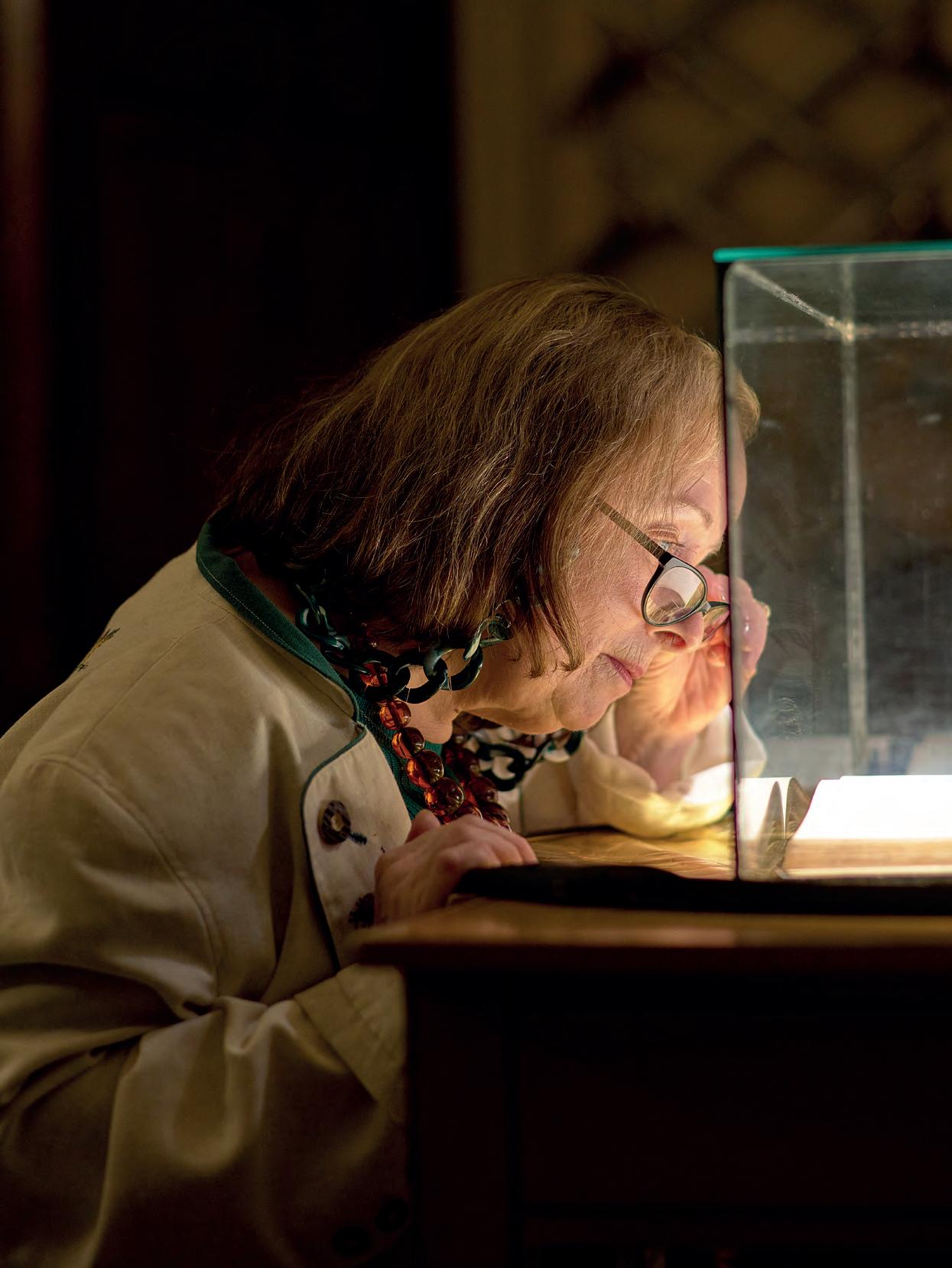
Caring for Scotland’s special places
Having completed conservation work on the historic painted walls and ceilings at Crathes Castle and on the 500-yearold statues at Falkland Palace, Head of Building Conservation Sarah MacKinnon reflects on the projects’ importance.

The painted walls and ceilings at Crathes Castle are a rare example of original Scottish Renaissance decoration that is still intact, and their conservation was long overdue.
Although the decoration was first applied in the early 17th century, the paintings were restored in Victorian times using brighter colours than the Renaissance palette. It was important that our conservation work focused on the authenticity of the original paintings, while also respecting the previous restoration work because it represents an integral part of the property’s history.
Specialist wall paintings conservator Karen Dundas secured and cleaned the paintings to protect their beauty and ensure their survival for years to come. We analysed samples of the original paint to expand our existing knowledge of the pigments and techniques used in the castle’s evolution. During this process, we found traces of orpiment, which was exciting – this yellow-orange pigment was made from arsenic, which would have been very expensive at the time.
The project also allowed us to look for evidence of other decorated areas – including the ceilings and alcoves of the Great Hall, the walls of the stair chamber and a fresco in the Chapel Chamber. Although we knew these areas of decoration probably existed, it was satisfying to observe skilled craftspeople apply their expertise to bring these stories to life, and our visitors appreciated being able to watch conservation in action.
Top: Head of Building Conservation
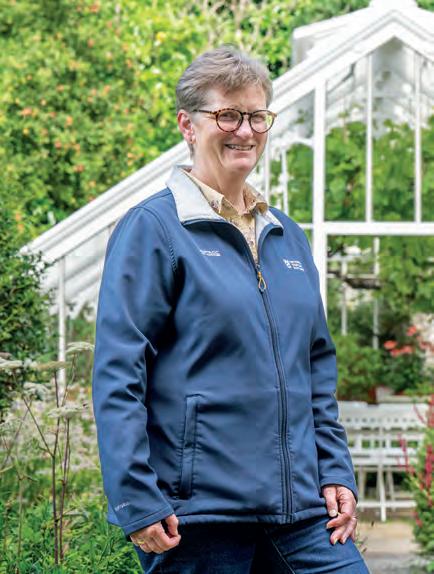
Sarah MacKinnon
Bottom: Inspecting one of the stone statues at Falkland Palace
At Falkland Palace in Fife, the second chapter of a three-phase conservation project was completed in 2022 when we conserved the three remaining 500-year-old statues mounted on the buttresses of the South Range. Centuries of natural deterioration were hastened by masonry bees burrowing into the stonework, creating tiny little cavities.
As with many of our conservation projects, we brought in specialists with an in-depth understanding of traditional stonemasonry techniques. This ensures that our properties are expertly maintained, and it also enables the Trust to support and enrich invaluable skills within the conservation industry.

After the statues were removed from the wall, stone conservator Graciela Ainsworth worked off-site to pin the cracks in each statue and fill more severe areas of delamination with resin to prevent further decay. As they have no practical function, the statues’ future safety was our priority, so we took the decision to create discreet new fixing brackets. We also restored and re-supported a number of original waterspouts, conserved and repainted armorial panels, checked the windows and repainted the yetts across the windows.
Now that the statues have been re-installed, we hope that they will continue to contribute to the story of Falkland Palace for centuries to come.
Both projects were part-funded by Historic Environment Scotland, through the Annual Repair Grant (part of the HES Organisational Support Fund), which allowed us to undertake significant amounts of work. We are very grateful to have been able to achieve so much.
A principal element of the Trust’s work is good management of our assets, and we are always balancing practicality with aesthetics.
Caring for Scotland’s special places
Sarah Beattie, Curator for the South West, describes the importance of providing public access to previously unseen Burns items.
A collection of 12 original manuscripts, letters and poems written by Robert Burns have been acquired by the Trust from the Blavatnik Honresfield Library.
Along with Burns’s invaluable First Commonplace Book, which was given jointly to the Trust and the National Library of Scotland, the items have been on public display for the first time in more than 100 years at Robert Burns Birthplace Museum.

The library was put together in the late 19th and early 20th century by William Law, a Lancashirebased industrialist. It was one of the finest literary collections of its time, including works by significant figures in British literary history such as Robert Burns, Sir Walter Scott, the Brontë sisters and Jane Austen.
After a successful campaign to save the entire library from being sold at auction, the Burns manuscripts from it were donated to the Trust by the Friends of the National Libraries in 2022. Our charity contributed towards this campaign – thanks to generous support received from donors in the USA and across the UK – alongside other partners from the heritage and culture sector in the UK.
It’s fascinating to see Burns’s handwritten additions, annotations and changes as he worked towards the finished version. The manuscripts are in incredible condition considering their age and only required minor pieces of conservation before being put on display in a temporary exhibition. We are now looking at ways to integrate the collection into our permanent displays, as well as digitising it to provide access online to people from all around the world.
An archipelago of eight islands in the Inner Hebrides, to the west of Staffa and Mull, the Treshnish Isles have recently come into the care of the Trust.
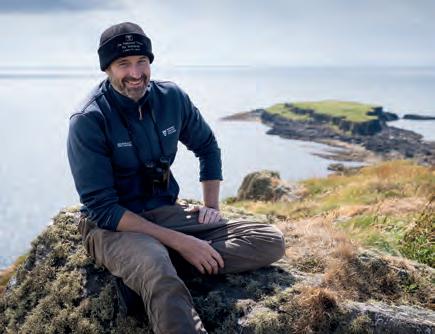
Although they are uninhabited and seemingly remote today, these islands have a rich history. Medieval chapels, a castle, an 18th-century barracks and a village last inhabited in 1857 all indicate that the Treshnish Isles played a key role in Hebridean life.
Today, the islands are a Site of Special Scientific Interest and the surrounding waters form part of the Sea of the Hebrides Marine Protected Area. Looking after the spectacular variety of seabirds – including puffins, kittiwakes, fulmars, guillemots, great skuas (bonxies) and storm petrels – is of paramount importance. We’ll build on the work begun by the Hebridean Trust, the former custodian, to ensure the islands are conserved and protected, and their stories shared with visitors and Trust members. We’re already working with local boat operators who bring visitors to the islands to promote the best ways of seeing the birds without disrupting their natural behaviour or disturbing their nests. It’s a real privilege for the Trust to have the honour of looking after the Treshnish Isles. It gives us the opportunity to secure the islands’ future so they are loved and protected for the benefit of the nation. We’d like to extend our huge thanks to Trust members and the National Trust for Scotland Foundation USA for helping us to do that.
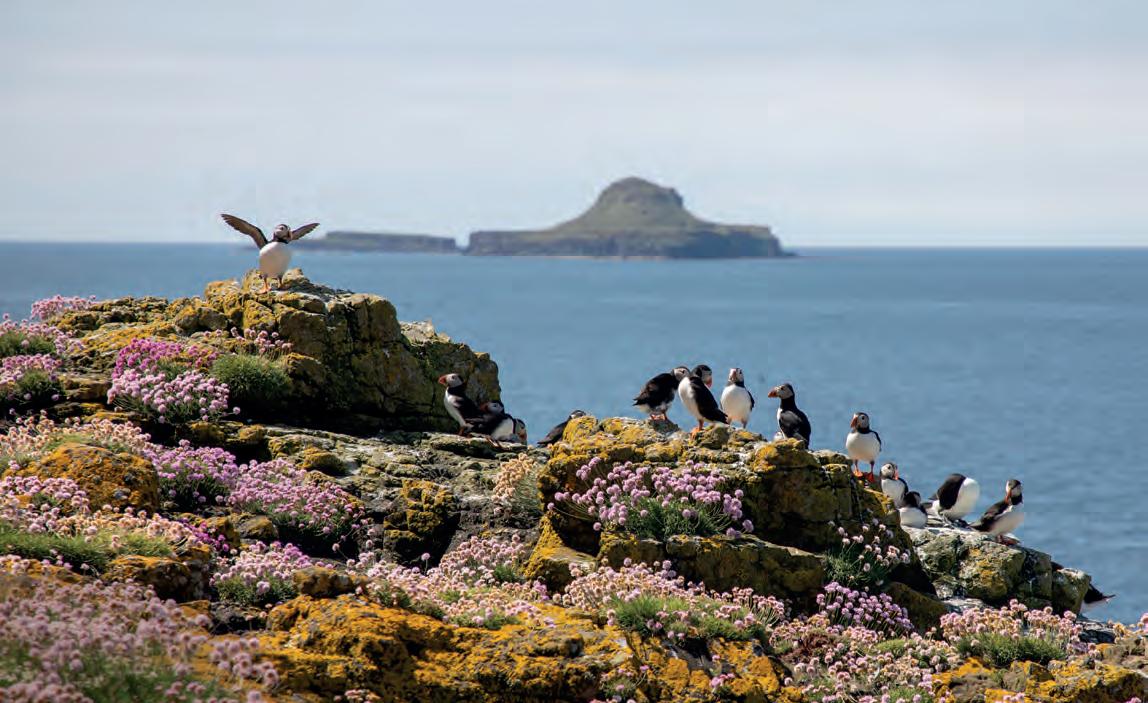
Our acquisition of the Treshnish Isles will enable us to carry out further surveying and monitoring to conserve and protect this very special area, says Will Boyd-Wallis, Operations Manager for the North West.Puffins on Lunga, one of the Treshnish Isles Will Boyd-Wallis
Caring for Scotland’s special places
Mar Lodge Estate’s Conservation Manager, Shaila Rao, explains why native tree planting in Glen Geldie is only the first step in an ambitious nature conservation plan to improve biodiversity and increase carbon sequestration.
Woodland expansion at Mar Lodge Estate in the Highlands has already been very successful, helping to boost biodiversity, reduce flood risk and increase carbon capture in the UK’s largest National Nature Reserve.

In Glen Geldie, riverside planting of 102,000 native trees of local provenance has just been completed; this will also help to improve the future health of the river.
Hand in hand with the tree planting comes peatland restoration – another important way to increase carbon storage and benefit biodiversity in this fragile landscape. By re-wetting areas of artificially drained and degraded peat, and encouraging vegetation regrowth, a healthy peatland system should emerge – full of wildlife and also capturing carbon.
In the past two years, 190 hectares of peatland have been restored, representing a fifth of the overall area that requires attention.
Signs are already positive: pools have appeared almost immediately, providing habitat for peatland species including dunlin and damselflies.
The River Geldie is also receiving attention. Trees will be harvested from commercial plantations on the estate this year, enabling woody structures to be added to the river in 2024. By interrupting the flow of water and creating eddies, in-channel vegetation will improve and there will be refuges for fish in flood events –essentially, this mimics what should happen naturally.
All this work has been made possible thanks to the Trust’s partnerships with the River Dee Trust, Peatland Action and the Cairngorms National Park Authority, with support from players of the People’s Postcode Lottery, funder Baillie Gifford and private donations.
Above: Shaila Rao planting a sapling
Left: Peatland restoration in action on Mar Lodge Estate NNR

Below: New growth among the heather

Caring for Scotland’s special places
Volunteers are playing a vital role in the Trust’s work to protect seabird populations, explains Ellie Owen, Senior Seabird Officer.
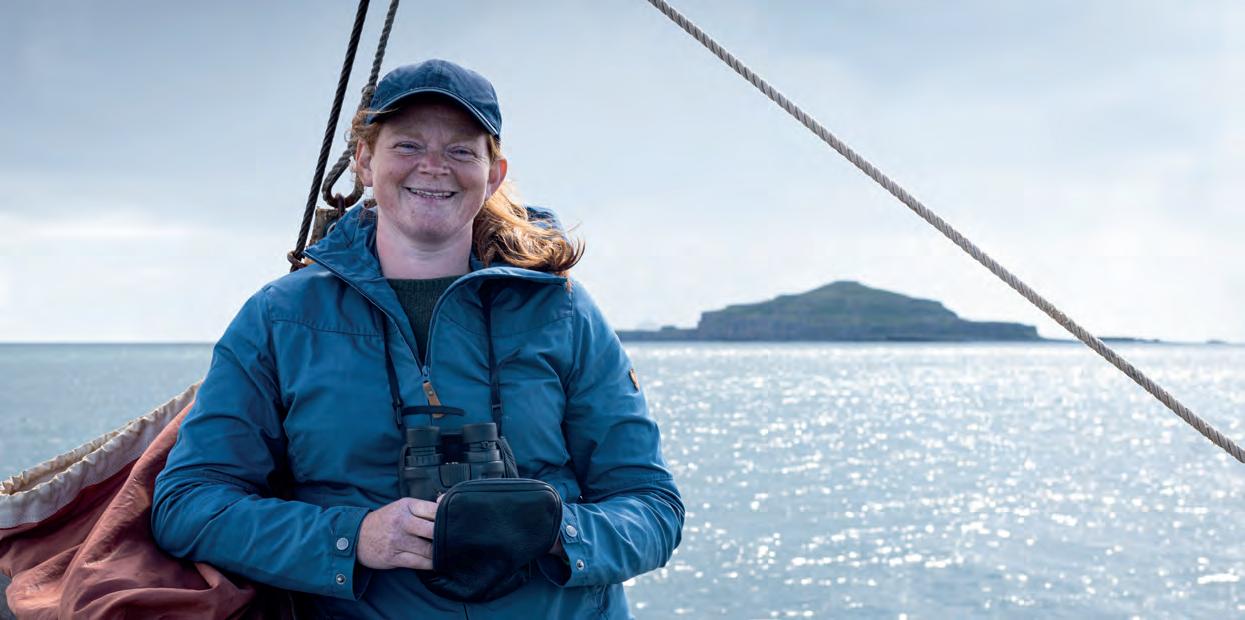
Avian flu is one of the big issues we are currently dealing with, and we have increased our seabird monitoring work.
The Trust already had a good monitoring programme in place on the islands and seabird cliffs in our care, but we are trying to do even more as part of a national effort to understand the impact of avian flu.
We have counted thousands of seabirds across our sites, including all of St Kilda’s cliff-nesting seabirds – that’s the first time the whole archipelago has been surveyed in a single year since 1999. It’s an incredibly difficult thing to do and was only made possible due to donations to our seabird appeal and dedicated funding from supporters Tim and Kim Allan (see page 37), combined with a remarkable effort from our rangers and team of volunteers. The data collected helps us better understand the problems seabirds face and gives validity to our campaigns where we speak up for seabirds.
Sadly, avian flu is only one of the threats affecting seabirds at the moment. We have called for an end to fishing for sandeels, which are a key food source for many of our seabirds. We have also been standing up for seabirds in regard to marine planning,
where we are arguing that the Berwick Bank offshore windfarm will have an unacceptable impact on seabirds, including those nesting at St Abb’s Head National Nature Reserve and the surrounding seascape. While the Trust supports offshore wind generation in principle, it must be sited in appropriate places, such as locations further offshore using floating wind turbines. Another threat comes from non-native species, such as rats, getting to our islands. We have carried out a huge amount of work on biosecurity to keep invasive mammals away – even our most remote islands now have monitoring and surveillance equipment.
Helping seabirds is something everyone can be involved in. Our citizen science project Seabirds, Camera, Action! kicked off this year, in which we’ve asked members of the public to submit photographs of seabirds carrying fish at any Trust place. This will help us monitor what food these birds are finding to feed their chicks.
Helping seabirds is something everyone can be involved in.
Scotland’s islands, coasts and seas are world-class in the wildlife they house and the ecosystem services they provide, as well as being hugely significant to local communities and the people who live in Scotland.
I’ve had the privilege of travelling all over the world, yet I keep coming back to how phenomenal our seas are here, at home.
The nature right on our doorstep is so valuable in terms of our ability to connect to the marine environment. That sense of wonder you get from going to the coast, and especially the islands, is incredible. You can take a short boat ride to some islands and feel like you’ve been transported to a different world. We have the opportunity to be part of raw, wild nature as it’s supposed to be – I think that’s so hard to find in many parts of the world.
I have struggled to find the words to explain how honoured I am to have been asked to become an ambassador for the Trust. I’ve had the great privilege of meeting many staff members and volunteers and learning more about their work. I can really sense the passion and pride they all have in protecting the important places in the Trust’s care.
The Trust’s vision aligns so closely with my own passions and beliefs in protecting what we have while also helping people experience it, so that they too can fall in love with nature, the ocean and all the incredible wildlife that lives there.
We are in a climate and a biodiversity crisis, and our seas and wildlife are at risk – yet this incredible organisation is using its voice to stand up for nature in a way that is very bold and very brave. It gives me a lot of hope.
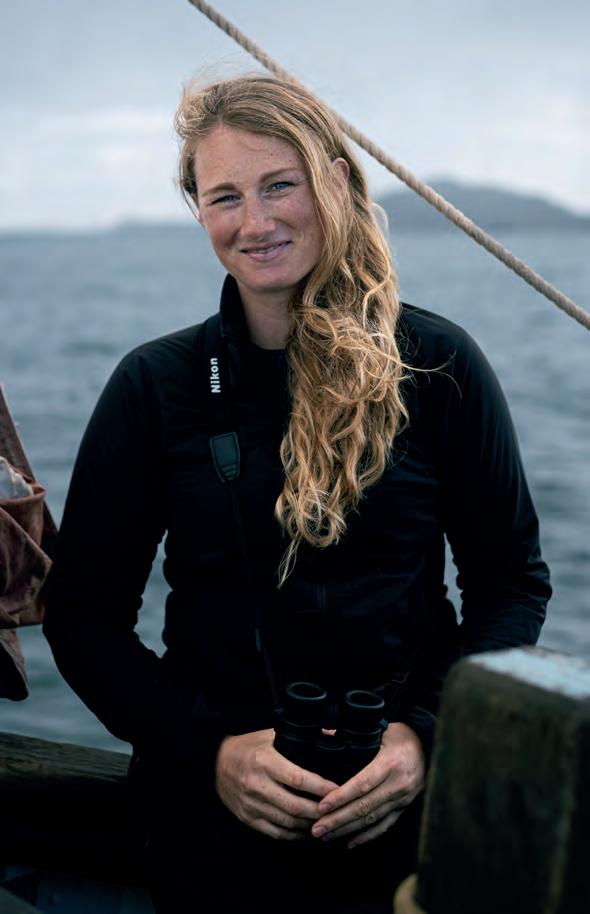
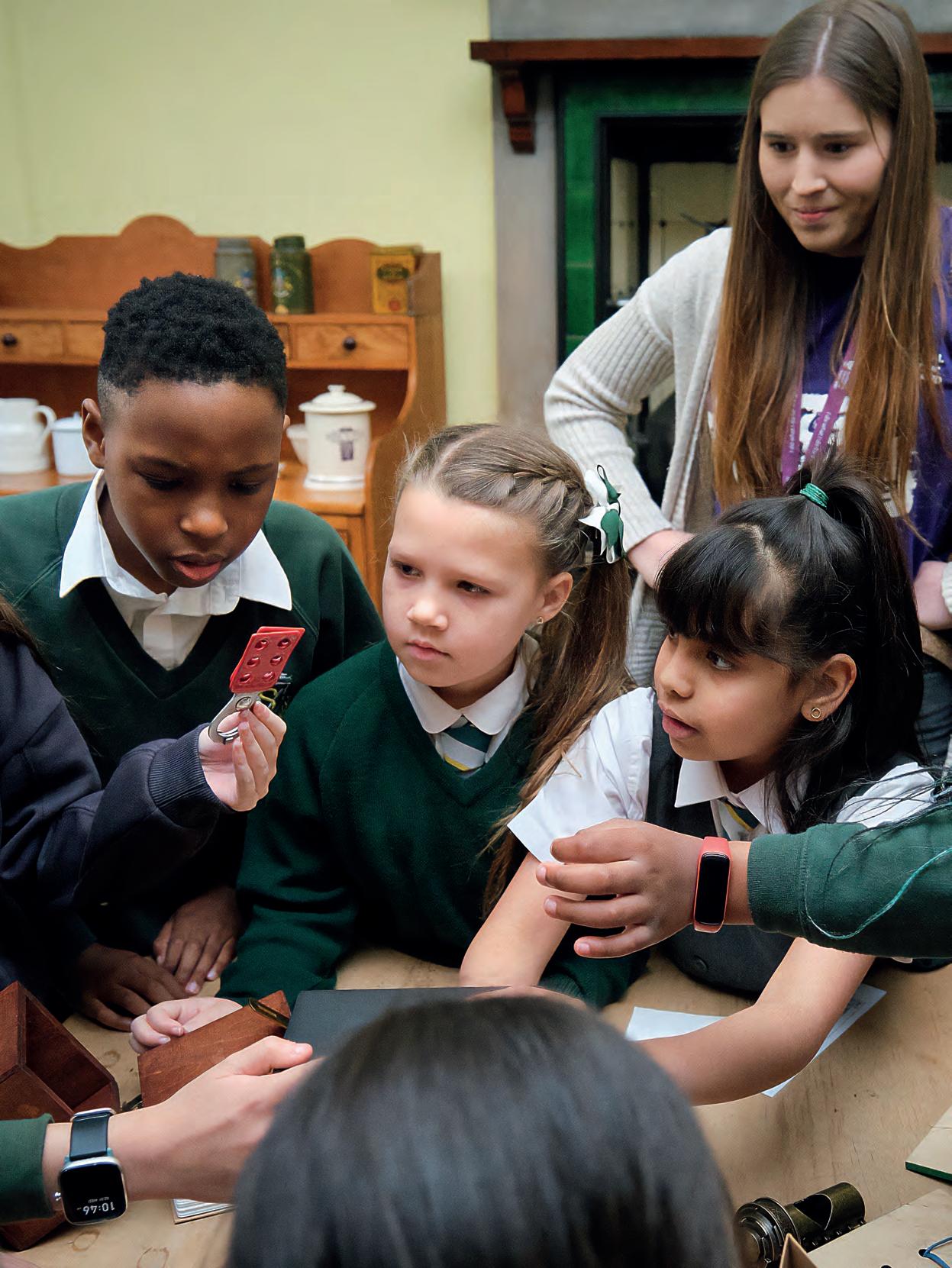
Providing access and enjoyment for everyone
Providing access and enjoyment for everyone
,
VisitorServices
Managerat Corrieshalloch Gorge National Nature Reserve, reports on the opening of the new Gateway to Nature Centre.

It’s very exciting in terms of what we’re now able to provide for the growing number of visitors to this area, a key stopping-off point on the North Coast 500.
As well as doubling the car parking spaces, we have electric charging points and a motorhome service point. There’s fresh water on tap for everyone, and Raven’s Rock Café has hot food and barista-style coffee (in either recyclable or compostable cups) to take away.
The new visitor facilities are impressive but are also sympathetic to the surrounding landscape. Visitors have complimented the striking ecofriendly design of the centre with its rainharvesting roof, the use of mature native timber … and the toilets – always a talking point because they feature a spectacular drone image of the gorge!
With the rush of the water, the sound of the wind in the trees, the birds singing – it’s a wonderful sensory experience.
A new pathway offers good access from the car park to the old Victorian paths and suspension bridge. There’s signage in Gaelic for the waterfalls, streams and burns; Douglas fir bridges to cross; and benches to sit on and immerse yourself in the sounds of nature. With the rush of the water, the sound of the wind in the trees, the birds singing – it’s a wonderful sensory experience.
This ambitious £3.1m project received significant support from the Natural and Cultural Heritage Fund, which is led by NatureScot and part-funded through the European Regional Development Fund.


The facilities are busy every day, which is testament to the success of the project. The ranger team will offer tours in the future, and there will also be further landscaping and planting to encourage natural regeneration and we will add more interpretation. I see this project as the start of a very special legacy.
Top: Corrieshalloch Gorge

Middle: The new Gateway to Nature Centre
Above: The suspension bridge
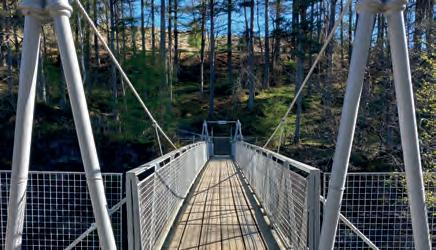
Providing access and enjoyment for everyone
By spring 2024, Craigievar Castle should be a glorious shade of pink again. John Lemon, Visitor Services Supervisor (Operations), shares an update on progress so far.


However, nature had other plans. The schedule had to be adjusted to accommodate a maternity bat roost and nesting birds, which led to the installation of Scotland’s first ‘house martin hotel’. We partnered with power supplier SSEN and a local science and technology youth group to build the tower, and the nesting pods have been well used. Extreme temperatures in June also affected the drying time of the lime mortar.
The famous pink harling applied to the exterior of Craigievar Castle dates to 1824. Harling was the traditional Scottish approach to weatherproofing castles, towers and dwellings. This project has given us an opportunity to put specialist masons to work in reviving traditional techniques by applying up to seven coats of a special recipe of limewash harling that, unlike cement, allows moisture to escape.
Achieving exactly the right shade of pink has caused much debate, and the conservation team have compared many samples in the quest to create Craigievar’s unique exterior limewash. We are very grateful for the support from the Pink Again fundraising appeal. While the scaffolding is up, we’re also taking the opportunity to repair windows and guttering. We’re making repairs to the pointing on the 16th-century barmkin wall – the last remaining piece of Craigievar’s original enclosing wall – and a specialist has been commissioned to check the plaster in the castle interior. One surprising discovery is that some of the castle’s ceilings may have displayed some colour in the past.
When the scaffolding around Craigievar Castle was completed in early January 2023, it marked an exciting stage in our ambitious project to future-proof the castle’s famous pink exterior.
The PLANTS project is the biggest horticultural audit project undertaken by the Trust to date.
It aims to celebrate, protect and better understand the flora and vegetation across our gardens and designed landscapes. Three regional teams have been creating a plant inventory across Trust gardens since June 2022, and we hope to have audited all of our most important gardens by March 2025.
So far, we have recorded 25,000 plantings across 9,000 taxonomic groups. We have worked very closely with the gardeners at each property because they have such in-depth understanding of their own plant collections; it’s wonderful to be able to benefit from their passion and expertise. It’s also important that we work in tandem because, when the PLANTS project ends, we will hand over responsibility for this data to our gardeners, who will then keep the records up to date.
The results have already been enlightening. We have potentially discovered some exciting varieties at Arduaine Garden, and we identified some unusual cultivars at Broughton House which were on Plant Heritage’s ‘Threatened Plants’ list. We hope to be able to share this data with other interested organisations when our audit is complete.
The PLANTS project has highlighted the diversity of the Trust’s plant collections and their importance to Scotland’s horticultural heritage, while also shining a light on the skills of our gardening team in helping these plants to survive and thrive.

Top: The PLANTS team in 2022 (Dr Florence is fourth from the left in the back row)
Middle: Roses catalogued by the PLANTS team

Above: A James Grieve apple label

Dr Anna Florence, Curator of Plant Collections, reports on progress in the Plant Listing at the National Trust for Scotland (PLANTS) project, and its contribution to Scotland’s horticultural heritage.
Providing access and enjoyment for everyone

Timesliders offers a dynamic, theatre-based approach to learning, which explores Scotland’s history through the adventures of fictional time-travellers Kyla and Eden.
The pilot programme began with a theatre show and digital podcasts in the classroom, followed by a visit to Pollok House where the children took part in a variety of problem-solving activities. The experience is immersive so that pupils don’t realise they’re exercising their numeracy, literacy and teamworking skills.
One of our clear objectives was to reach children who would otherwise be unlikely to engage with the Trust. We worked with Glasgow City Council to identify local schools with broad demographic diversity, including a high percentage of pupils living in areas of deprivation. A total of 14 classes across 3 schools participated in Timesliders, with 378 learners visiting Pollok House, accompanied by 42 teachers and helpers.
We’re thrilled with the results as it’s a completely new approach to educational engagement and has been deliberately developed to reach primary school pupils across a broad age range.
The children loved Timesliders, and feedback from the adults was equally positive; many of the teachers said it was the best schools programme they had ever been involved in. All said the project would make them more likely to visit a Trust place.
 Sarah Cowie, Senior Heritage Learning Advisor, reflects on the success of the Timesliders pilot project at Pollok House.
Top: Sarah Cowie at the launch of the Timesliders project
Sarah Cowie, Senior Heritage Learning Advisor, reflects on the success of the Timesliders pilot project at Pollok House.
Top: Sarah Cowie at the launch of the Timesliders project
In 2021, the Trust developed a bold new formal learning strategy, and Timesliders is the first programme to be delivered in line with that.
Using our Young Scot National Entitlement Cards to enjoy £1 admission has made a massive difference.



I’ve recently graduated and, like so many young people, I’m finding the cost of living really high. I’m always looking for things to do on my days off with my boyfriend and friends – we like to go on day trips.
The link-up between the National Trust for Scotland, Historic Environment Scotland and Historic Houses gives you the chance to visit new places and explore Scotland’s heritage. I think it’s important to understand where you come from – not just your country but you personally. My mum works at Crathes Castle and, after doing our family tree, discovered that we have distant links to the family who once lived there. There’s so much to learn from visiting a Trust place!
It’s not just about visiting castles and historic buildings; there’s so much to explore in the gardens and estates as well. Experiencing these pockets of nature is so important for young people concerned about the climate crisis – they can see what the Trust is doing and actively support a charity that’s taking steps to tackle the issue.
The opportunity to get outside and into nature makes such a difference to your mental health and wellbeing, whatever your age.
An initiative offering £1 entry to holders of a Young Scot card is one of the best deals around for young people, explains Will Evans, Visitor Services Supervisor at Gladstone’s Land.Top: Young Scot card holders Above: Will Evans in the Gladstone’s Land ice cream parlour

Being a sustainable charity

Being a sustainable charity
Presenting the successful Love Scotland podcasts has been the perfect opportunity to reach new audiences, finds Jackie Bird, who was appointed as the Trust’s President in 2022.
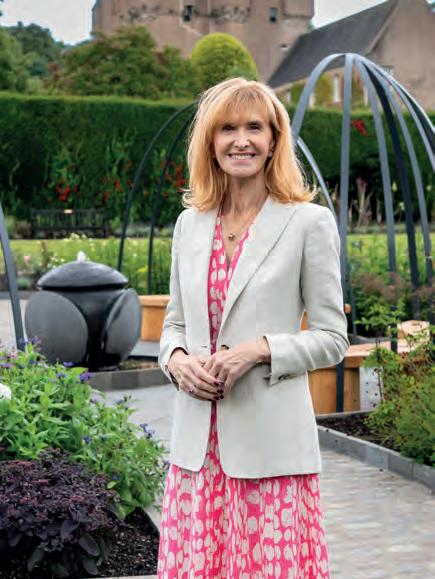
The National Trust for Scotland’s podcasts are a great way for the Trust to showcase its treasures and its people. In just a few years, podcasting has gone from a niche method of communication to a vast and ever-expanding media platform.

It offers a deep dive into subjects tailored for each listener’s preferences, which happens to fit perfectly with the wealth of historical content and conservation expertise shared by the National Trust for Scotland.
During my career as a broadcast journalist, I never lost the thrill of bringing viewers the day’s news. I get the same excitement passing on the facts about the people and places I learn about in the podcasts. It doesn’t matter that this information can sometimes be many centuries old – if you didn’t know about it already, then it’s news. Podcasting is also an opportunity to reach new audiences. Can you believe there are history buffs out there, or people keen on environmental issues, who haven’t yet considered the many advantages that membership of the Trust can bring? I consider the Love Scotland podcasts an opportunity not only to broaden the knowledge of Trust members with in-depth interviews about their favourite places or periods of history, but also a chance to reach a new and responsive market as we nudge listeners towards joining the Trust. We’re certainly spreading the word. I hope you’ll forgive my lack of modesty in revealing that last year the series won not only Podcast of the Year at the PPA Scotland Awards (Professional Publishers Association), but also the Brand Extension of the Year category.
We strive to find the very best interviewees, drawing on the wealth of knowledge within the Trust itself.
The geographic range and diversity of buildings and landscapes cared for by the Trust mean we are never short of subjects to focus on. However, we also use Trust places as launch pads to investigate and analyse the eras and societies in which they existed. For example, Gladstone’s Land on Edinburgh’s Royal Mile was the focus point for an episode on Scotland’s 300-year experience of recurring outbreaks of plague. Standing in the room where desperate people once queued for the herbs and spices they hoped would save their lives gave me a visceral experience of history that sent shivers down my spine.
We strive to find the very best interviewees, and that includes drawing on the wealth of knowledge within the Trust itself. Our rangers are an example of the inexhaustible sources of in-house expertise about conservation and our natural world. In Season 6 we chatted to Alasdair Eckersall, who has looked after the magnificent landscape of Ben Lomond for more than 30 years – an incredible depth of sustained, onthe-ground experience. At other times, we go in search of leading academics and external experts
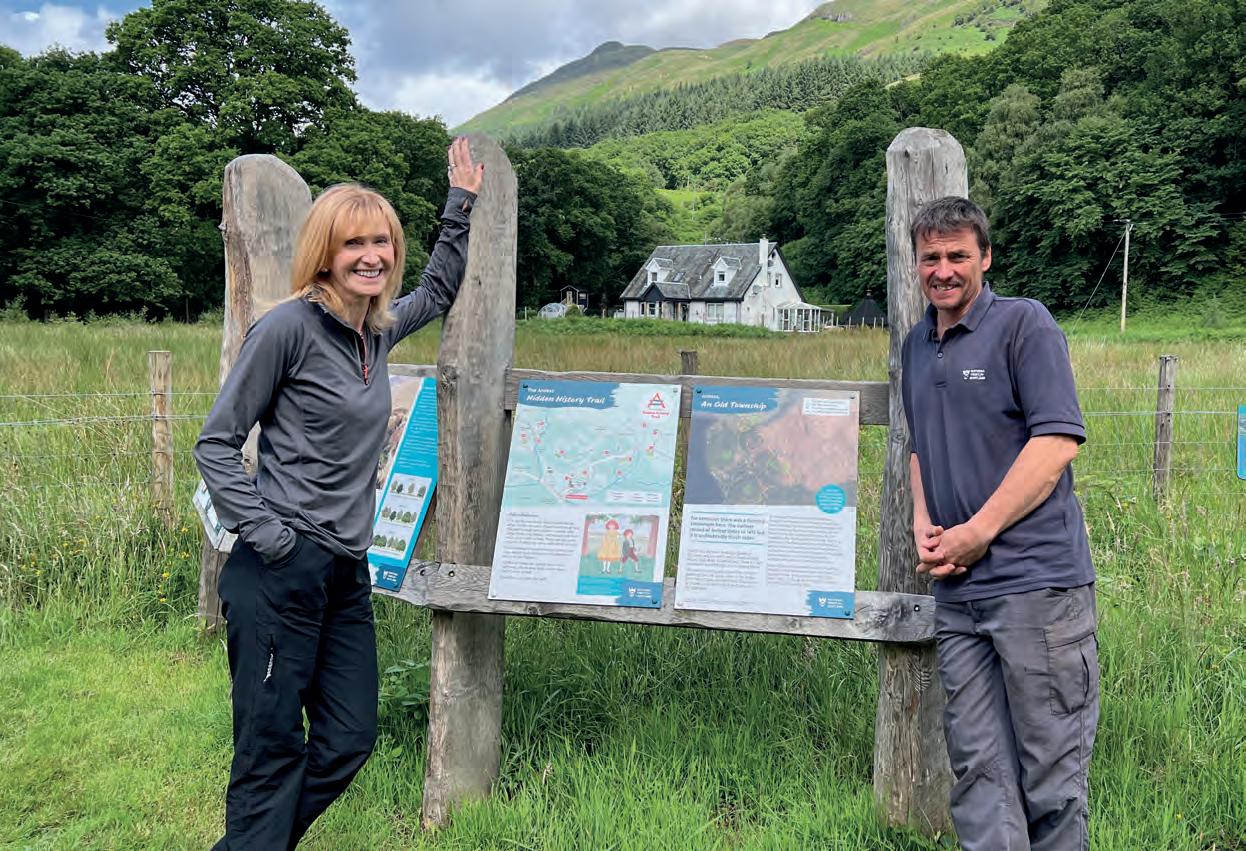
whose work dovetails with Trust issues and places, from eminent historians such as Sir Tom Devine to a new generation of scholars such as Steven J Reid, who has spent years researching the early life of James VI at Falkland Palace.
My role as President has meant I’ve enjoyed a year of learning about the scope and scale of the Trust: its accomplishments, its challenges and its vision for the future. I’ve met staff and volunteers, and relished not just their enthusiasm for the job but also their deeply felt custodianship of the places they look after. Through the podcasts, I’ve been able to contextualise why it’s so important that we look after our heritage and the landscapes and wildlife around us. It’s also been great fun to meet people in the street who can’t wait to tell me proudly that they are members of the Trust – it’s like we share a special bond.
Being a sustainable charity
The Patrons’ Club is not so much a club as a fabulous family of friends, who are motivated to protect and promote Scotland’s heritage.
 A ranger monitoring seabirds on St Kilda
A ranger monitoring seabirds on St Kilda
Tim Allan and his wife Kim are members of the Trust’s Patrons’ Club. Their generosity makes a huge difference to our work, particularly in caring for seabirds.
who have a deep love for Scotland and its heritage. The Patrons’ Club is not so much a club as a fabulous family of friends, who are motivated to engage in the efforts to protect and promote that heritage.
It’s up to those of us who are able to give to demonstrate to others that this charity can’t survive without significant generosity from a range of supporters.
We are members of the Patrons’ Club, an international collective of like-minded individuals
Kim’s degree is in marine biology, and she is a lifelong birdwatcher. We both love nature and want to address the crisis facing global bird populations. Through the places in its care, the Trust is home to more seabirds than any other landowner in Scotland. This carries both responsibilities and costs, especially at this time of climate crisis and avian flu. We have committed to fund the senior seabird officer role (and all the support it needs) for three years.
We believe that when you choose to provide philanthropic support, it should be fundamentally strategic to enable the specified project. We are fortunate to be in a position where we can fully fund this project so that a real difference can be achieved.
We were lucky to have the opportunity to go to St Kilda to find out more about the work being carried out there by the ranger team. It was an extraordinary experience to further understand the project, work with the team and get a better opportunity to observe the birds. Kim is keen to return and help as a volunteer.

We don’t seek to impose any restrictions on our support, but there has to be something which sparks joy for us. Therefore, supporting specific projects like the seabird monitoring and research achieves our philanthropic ambition to enable a great team to do great work in a demanding field. Being able to see it first-hand, and even to play a small role in their work, is deeply fulfilling and very rewarding.
Our Patrons’ Club members are passionate about the work of our charity and share our ambitions to inspire those around us to connect with the things that make Scotland unique. Their support helps us conserve and protect Scotland’s rich heritage now and for future generations. A special programme of events, trips and talks give the Patrons’ Club behind-the-scenes access to the work at the Trust.
For more information on the Patrons’ Club, see nts.org.uk/patrons-club or phone 07835 235375.
Kim and I believe it’s important to align your interests with a worthwhile organisation doing great work, and that’s why we support the National Trust for Scotland.
Being a sustainable charity
Climate Change Coordinator Harriet Cross, who joined the Trust in January 2023, explains how her role will help to drive collective change.

The Trust has a massive role to play in tackling climate change, because it is responsible for a large proportion of Scotland’s natural assets and built heritage.
Much of what we protect is already being affected by the changing climate, and so we need to proactively adapt and become more resilient. We also need to change our practices to reduce our own impact – through the way we work, how we heat our buildings and how we get around.
Significant work is already happening to reduce our carbon footprint, and many of our properties and estates are taking positive steps to mitigate and adapt to the effects of climate change. Heating systems are being replaced
with renewable energy solutions; Food and Beverage teams have introduced more sustainable products, like Fairtrade-certified coffee and reusable water bottles made from 100% recycled aluminium; and staff-led Green teams have taken on challenges at various sites. Through our woodland creation and peatland restoration work across Scotland, we can play a larger role in reducing carbon emissions, as these nature-based solutions capture and sequester them.
To streamline this work and drive momentum, we are developing an organisation-wide climate change strategy.
We have set up a new Climate and Environment Group, with representatives from across the Trust, who will help to guide the changes needed. We are also starting to calculate the carbon emissions of our buildings and operations, as well as from staff travel, procurement and our investments. Once we have an up-todate baseline figure, we can determine more collectively how we can cut emissions, and the interim targets required to measure our progress.
All this mapping work will help form the framework for a new Climate Action Plan that will, ultimately, be shaped by the whole organisation. The Trust’s decisions need to be climate-informed, so this plan will underpin much of what we do and will be owned by many across the Trust.
Driving change is a collective effort, but so much fantastic knowledge already exists within the organisation. It’s part of my role to bring those insights together and put the foundations in place for an effective climate change strategy.

Many of our properties and estates are taking positive steps to mitigate and adapt to the effects of climate change.The new, low-maintenance parterre at Pitmedden Garden
Being a sustainable charity
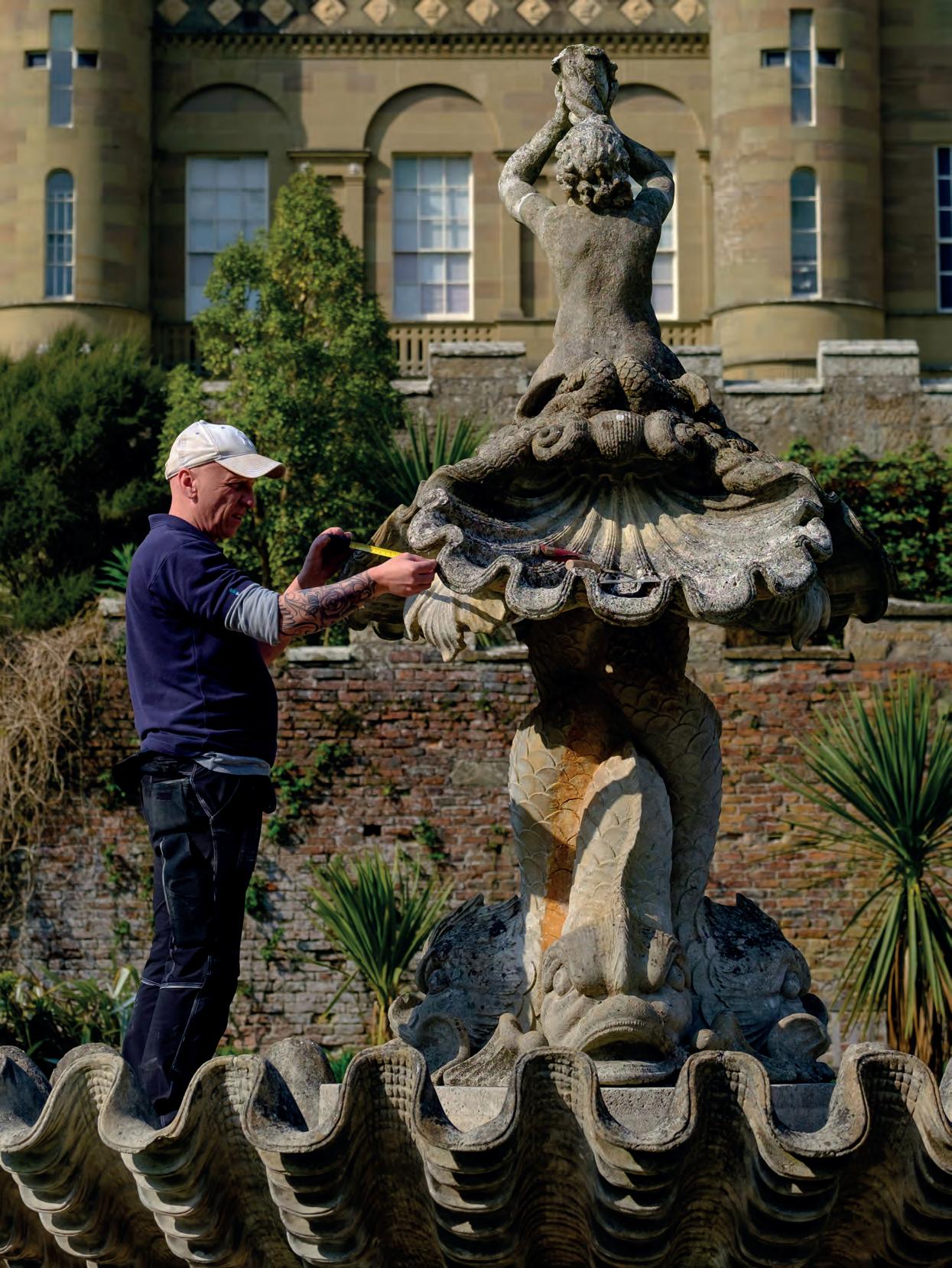

I joined the Trust in January 2023, and it’s my privilege to support and contribute to the strategic direction of our charity.
That includes all aspects of looking after our workforce; engaging with our fantastic volunteers; shaping the Trust to best overcome challenges and deliver objectives; encouraging collaborative ways of working in a supportive culture; talent management; reward and recognition; and equality, diversity and inclusion.
We’ve reorganised the People team to provide a more effective service to the Trust. This includes deploying managers to look after each region and directorate, with the task of getting to know their needs and requirements, thus developing a closer working relationship and a better understanding of issues across the country.
Having good systems and data is important for any organisation so that people management is smooth and supportive. One of our areas of focus is to improve our IT systems, including the
introduction of an e-recruitment platform that’ll make it easier to bring in the talent and skills we need.
Similarly, we’re embarking on a root-and-branch review of our recruitment processes, finding ways that we can better demonstrate how the Trust is an attractive and progressive place to work. Meanwhile, our equality, diversity and inclusion agenda ensures we’re an organisation that is open to all, as part of our mission to have a diverse workforce and be understood as a welcoming employer.
Like many organisations, we’re taking a fresh look at our flexible and hybrid working policies post-pandemic, to make sure they are still fit for purpose. Our New Ways of Working project looks at exactly that: how our people can operate more flexibly as part of a cohesive and mutually dependent workforce.
During my first six months at the Trust, I’ve focused on developing a more structured approach to improving our communication with staff and volunteers. I’m determined to shape a People function that is fundamentally attuned to the needs of our people, so that they in turn can care for Scotland’s vitally important heritage.
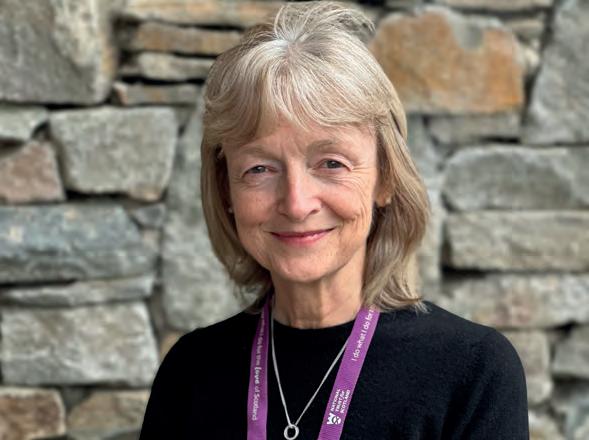
Like many organisations, we’re taking a fresh look at our flexible and hybrid working policies postpandemic, to make sure they are still fit for purpose.
Being a sustainable charity
There are opportunities for everyone to get involved with protecting Scotland’s heritage and nature.
More than 2,000 volunteers play a vital role in the National Trust for Scotland. Chris Armstrong found a way to put his passion for history to good use after graduating.
I have always had an interest in history and when I finished college I found an opening as a volunteer at Culloden.
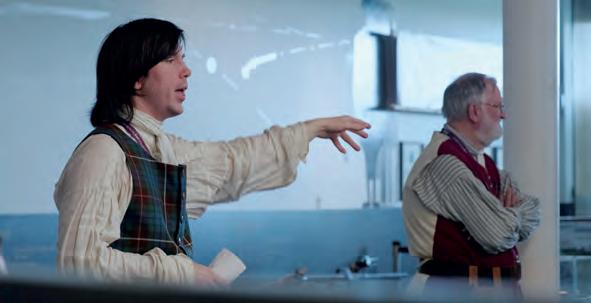

I take part in presentations to visitors, talking about the history of the place and of Scotland. I enjoy seeing how people react when we tell them a story from the past. We do it in a fun way so it’s not a boring lecture!
I also help out with other jobs here – washing,
cleaning and repainting the benches for important events; doing archaeology; and generally making a fun experience for visitors. If you’ve just left college, volunteering can be a great way to get work experience. It’s good fun.
I’d just moved to the area and visited Crathes with my mother. I could immediately tell this was a special garden; it’s a magical place.
I encountered the head gardener on that first visit and asked if there were any volunteering opportunities.
I enjoy every minute of it. One of the great benefits of volunteering is that you get to meet people from all over the world; you feel really proud when they tell you what a great garden it is.
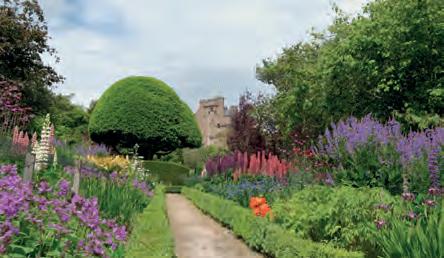

The staff are amazing. They teach you everything you need to do and really make you feel like you’re part of the team. They’re a super fun bunch and it’s been great getting to know people, especially as I’d only just moved here.
I got to prune a rose for the first time, and when I walk past and see it flourishing, I’m so thrilled.
The National Trust for Scotland has a whole range of opportunities for people of all abilities and all passions. The pride you feel in contributing to making a place better is always going to be a good thing.

Being a sustainable charity

(such as shops, cafés, holiday accommodation, weddings and other events) and, importantly, from fundraising.
Fundraising income ranges from gifts left to the Trust in Wills and lifetime donations to our work, to donations towards specific fundraising campaigns, such as the successful Footpath Fund. Donations, whatever their size, are extremely important to the Trust – we are very grateful to numerous individuals, our Patrons’ Club, our Founders’ Circle, many companies, trusts and foundations, and our supporters in America via the National Trust for Scotland Foundation USA.
With such a vast portfolio of properties comes a significant responsibility for ongoing investment – in land management, repairs, conservation, research, visitor experience and much more. Although some projects had to be paused due to the impact of the pandemic, since 2018 we have invested over £60m in maintaining and enhancing our properties. We have plans not only to continue this programme of investment but to accelerate it, and so fundraising will become ever more important.
The Trust is an independent charity set up in 1931 to ‘preserve and care for land and buildings north of the border’; it’s now the largest conservation organisation in Scotland.
With more than 315,000 members and 3.6 million visitors every year, we require substantial resources to operate and care for the Trust’s places. The Trust’s revenue comes from a number of sources including membership subscriptions, property admissions, commercial income
In the coming years, we have some larger projects in our sights, such as at the Hill House in Helensburgh – Charles Rennie Mackintosh’s masterpiece requires major renovation before the protective Box can be removed. In addition, major conservation work is currently being planned for Fyvie Castle in Aberdeenshire. These large projects will require more substantial and focused fundraising exercises to be undertaken over the next few years. The Trust’s Board members are hugely grateful to all those who support the Trust in so many ways. In doing so, you help us to ensure that all the Trust’s assets will be maintained, protected and accessible for future generations.
importance of fundraising in the Trust’s future plans.
Since joining the Board of the Trust last year, I have learned a great deal about our complex organisation and I have never ceased to be impressed at the commitment and enthusiasm for our charity from so many people, be they Trust employees, volunteers, members or visitors.


‘Nature, beauty and heritage for everyone’ means just that: facilitating access for as many people as possible. Offering training to Trust staff and volunteers has been a way to put the Facing Our Past project into practice. Giving everyone an opportunity to ask questions, connect with each other and become confident in delivering an expanded narrative has been a real success. Facing the difficult realities of the past together through dialogue reveals a shared history in a way that leads to greater unity.
I have also been trialling new approaches to community engagement. I facilitated a pilot project for young people using writing, performance and film linked to the historical stories of Newhailes House, aimed at engaging younger audiences. Some of the young people had visited as children with their families and gained a renewed interest by seeing it in a different light, while for others it was a novel, exciting experience.
A project at Pollok House that focused on the property’s links to Jamaica attracted adults from a variety of backgrounds and ages. We hosted a session at the Mitchell Library in Glasgow (complete with Caribbean teas and rum cake) on the challenges of archival research and discussed what we wanted to see in heritage organisations and how to create inclusive approaches to history.
We then hosted ‘Rum and the Drum’, an evening of rum tasting led by a master distiller. Vibrant Caribbean music and dance was greatly enjoyed by staff and people of Caribbean heritage living in Glasgow.
These unique and enjoyable opportunities assist the Trust in building strong community relationships by supporting honest conversations and understanding different perspectives. In turn, this helps staff and volunteers at the Trust to build the confidence needed to discuss sensitive history, such as Caribbean enslavement, with a variety of audiences.

Offering new perspectives on our places has been important for the Trust and our visitors, finds academic researcher and heritage consultant Lisa Williams
.
Above:The Ladies of Midnight Blue performed at ‘Rum and the Drum’
The Trust’s Facing Our Past project researches the legacies of slavery in Scotland as part of the extensive research we undertake into topics and issues of interest and concern to the Trust.
Hannah Copestake, member of the Trust’s Pride Workforce group, explains how the roles and histories of LGBT+ people at some of our places have been further explored this year.
Recently, the Trust’s Pride Workforce group attended public Pride events across Scotland for the first time.

While staff had previously attended as individuals, this year marked an important step as we attended to officially represent the National Trust for Scotland. We were delighted to offer staff the opportunity to march if they felt comfortable doing so, and we offered support at multiple locations across Scotland. The group attended Edinburgh Pride, Inverness Pride and Moray Pride in 2023, and hope to attend further events in 2024.
Increased visibility in the Trust and the support to publicly showcase our diversity has been deeply appreciated by the network. After attending the marches, we shared some social media posts as well as a series of blogs exploring the queer history of some of our collections. We are actively supporting the
further exploration of queer stories in our places, working to increase collaboration with LGBT+ networks at other Scottish heritage organisations and offer more support and networking opportunities for colleagues as part of the Pride Workforce group.
The operations for the year generated a deficit of £7.8 million, an improvement on the budgeted deficit of £12.8 million. The deficit is higher than recent years due to two main factors: a £7 million rise in salary costs year-on-year, predominantly driven by a return to pre-pandemic staff numbers; and an increase in planned maintenance and conservation work that had been delayed during the pandemic.
This work has been funded using a combination of sources from grants, restricted funds and general reserves. By moving to longer-term planning, rather than annual planning, it is our strategy to achieve a financial operating break-even position.
Pillar Objective by 2032 KPI
CONSERVATION
Our heritage assets are in a stable and improving condition.
ENGAGEMENT We are known as a leading provider of inspiring visitor experiences in Scotland to a diverse audience of over 6 million visitors a year.
By 2032, half a million members will have supported over £100 million of investment in conservation, access and learning.
SUSTAINABILITY We have reduced our environmental impact and will be carbon negative by 2031.
We are financially secure, balancing our income with over £100 million of capital investment over the lifetime of this strategy, while maintaining enough reserves to ensure our long-term resilience.
Our volunteers and staff are equipped with the systems and skills they need.
Performance Index (CPI) 1 – tracking the % of a sample of heritage assets in a good condition
visitors across all Trust properties within the year
1 The Conservation Performance Index (CPI) is used to measure how well we are putting conservation into practice at our properties.
2 This is a measure of the response to the question ‘I would recommend the Trust as a good place to work’ from Trust employees and volunteers.
The full report and accounts are available at nts.org.uk
The National Trust for Scotland’s work has never been more important than it is today.
Our staff and volunteers work tirelessly to care for our special places and champion Scotland’s heritage for everyone to enjoy, now and in the future.
The generosity of our supporters enables us to conserve 352 listed buildings, protect the wildlife living in 8 National Nature Reserves, maintain 245 miles of mountain footpaths and inspire future generations to discover the stories linked to our fascinating objects from the past.
We couldn’t do this vital work without our supporters. Find out more about our work and how to support us at nts.org.uk
Thank you.

nts.org.uk
The National Trust for Scotland for Places of Historic Interest or Natural Beauty is a charity registered in Scotland, Charity Number SC007410
Registered address: Hermiston Quay, 5 Cultins Road, Edinburgh EH11 4DF